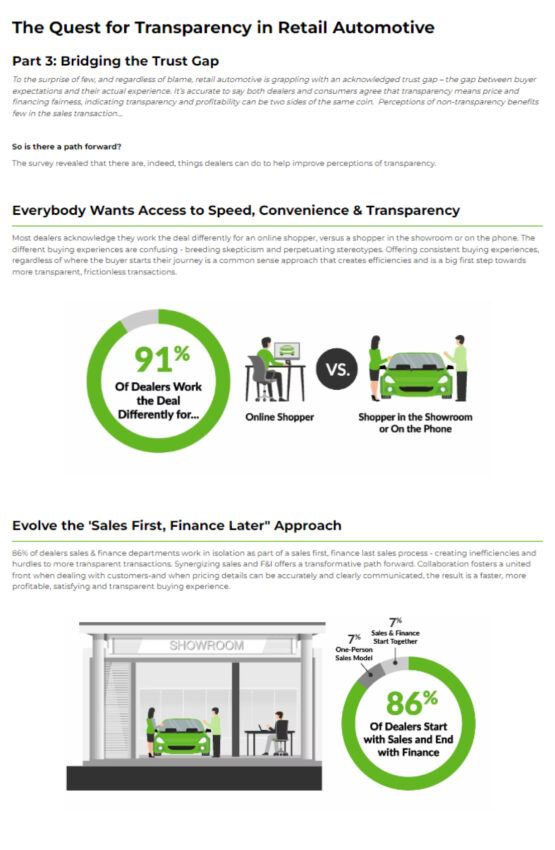The Quest for Transparency in Retail Automotive (Part 3)
DOWNLOAD INFOGRAPHICIn this article
The Quest for Transparency in Retail Automotive
Part 3: Bridging the Trust Gap
To the surprise of few, and regardless of blame, retail automotive is grappling with an acknowledged trust gap – the gap between buyer expectations and their actual experience. It’s accurate to say both dealers and consumers agree that transparency means price and financing fairness, indicating transparency and profitability can be two sides of the same coin. Perceptions of non-transparency benefits few in the sales transaction…
So is there a path forward?
The survey revealed that there are, indeed, things dealers can do to help improve perceptions of transparency.
Everybody Wants Access to Speed, Convenience & Transparency
Most dealers acknowledge they work the deal differently for an online shopper, versus a shopper in the showroom or on the phone. The different buying experiences are confusing – breeding skepticism and perpetuating stereotypes. Offering consistent buying experiences, regardless of where the buyer starts their journey is a common sense approach that creates efficiencies and is a big first step towards more transparent, frictionless transactions.

Evolve the ‘Sales First, Finance Later” Approach
86% of dealers sales & finance departments work in isolation as part of a sales first, finance last sales process – creating inefficiencies and hurdles to more transparent transactions. Synergizing sales and F&I offers a transformative path forward. Collaboration fosters a united front when dealing with customers-and when pricing details can be accurately and clearly communicated, the result is a faster, more profitable, satisfying and transparent buying experience.

Embrace Digital Finance Innovations that Solve Transparency Challenges
Dealers clearly are looking for solutions, with 95% seeing value in a pre-desking tool integrated with lender credit score models. Advanced digital desking solutions offer accurate and actionable deal structuring options, aligning with consumer expectations of deal clarity and fairness. They can also be configured to include F&I protection plans, commonly unlisted dealer fee structures and taxes – and dealer reserve. The two-way transparency is a trust multiplier and as the importance of trust grows, so does the likelihood of a profitable deal.

Conclusion
As the automotive industry evolves to meet changing consumer expectations, the future favors dealers who can balance transparency with profitability – online and offline. Transparency is not about offering the lowest price; it’s about deal clarity and fairness. Closing the trust gap is not just ethical; it’s good for business. Lenders and dealers both have a role. Unifying the start of sales and finance activities, combined with evolved digital finance tools, offer a pathway to bridge this gap, proving that transparency and profitability can coexist and even complement each other.
This concludes our 3-part Quest For Transparency infographic series. You can view Part 1 here.
Source: 2023 survey of over 350 auto dealerships across the U.S., fielded by eLEND Solutions
